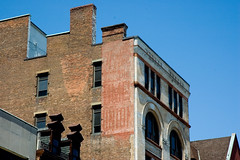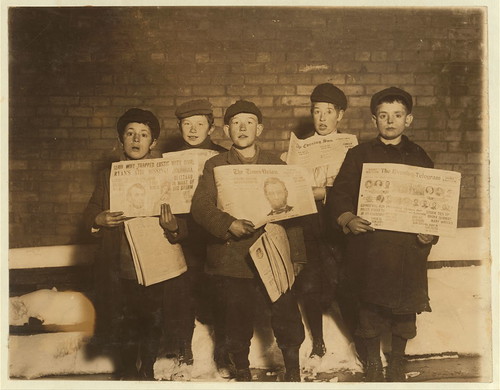Albany Newsies, 1910
This photo by celebrated photographer Lewis Wickes Hine shows a group of newsies selling evenings in saloons and stores. It was taken in an alley in back of the City Jail at 10 P.M. Left to right: Dominick Mardilo, 28 1/2 Fulton Street; Roderick Towle, 44 Sheridan Ave.; William Towle, brother, 44 Sheridan Ave.; Louis Strasburg, 40 Mulberry Street; Max Erlich, 101 Dallius Street.
Lewis Wickes Hine was a sociology professor who used photography as a tool for reform; this picture and many others that preserve bits of Capital District and national history were taken for the National Child Labor Committee; Hine’s work was some of the earliest documentary photography. His work helped bring about child labor laws but, more importantly to me, he preserved images of people and places that would otherwise never have been documented.
Four daily newspapers are captured here – the Evening Journal, the Times-Union, the Evening Sun, and the Evening Telegram. Although Albany probably had at least seven daily newspapers then, I think the Sun and the Telegram may have come upriver from New York City. If there’s an afternoon newspaper alive today, I’m unaware of it; Albany’s last, the Knickerbocker News-Union Star, died in 1988. Officially, it merged into the Times-Union, which had long since switched to morning production. Lincoln’s image is prominent because it was his birthday, then celebrated on his actual birthday, February 12, because the mattress sales interests hadn’t yet gotten hold of Congress and merged Lincoln’s and Washington’s birthdays into a single day of weak remembrance.
There’s more . . . .

“You’ll like the Times-Union” by carljohnson via Flickr
If they were behind the Albany City Jail, I believe they were on Howard Street; the old Albany City Jail building was built by Philip Hooker in 1810. Hine also captured the boys playing craps in the alley.
The Times-Union then was at a fairly new location at the corner of Beaver and Green Streets, having outgrown its former storefront beginnings at Munsell’s printing operation on Broadway; it would move again to Sheridan Avenue in 1950 before leaving the city entirely in 1970, while continuing to decry its decline. The Evening Journal is forgotten, but its building is familiar to every Albanian, whether they know it or not. It is at the end of the SUNY Central Administration Building on Broadway. Why the Delaware and Hudson Railroad and the Evening Journal chose to have their headquarters butt up against each other in Marcus T. Reynolds’s fantastic design has never been clear to me, but as the D&H long outlasted the Evening Journal, most folks just think of it as the old D&H building. The newsie is holding an “Eighth Edition Extra,” the stuff of newspapering and film legend, from a time when newspapers would make changes throughout the daily press run, updating articles on the fly and sending armies of newsies out to cry out “Extra!” Now blogging has, in a way, brought editions back to newspapering, except of course without all the paper and ink.
Vying with Lincoln for attention was the sensational murder trial (at the time, pretty much all murder trials were sensational) of Maurice Lustig, who would be found guilty that May of slipping strychnine (then available at all the finer pharmacies) to his wife. Bigamy, confused alibis, insurance money, sham postcards sent out while his wife lay dying – this one had it all. Sentenced to death, Lustig received a new trial after two years in Sing Sing, but what happened then is too far outside of this picture.
What became of these newsies? I couldn’t learn anything about Dominic Mardillo. Brothers William and Roderick Towle were living with and taking care of their parents at 17 Monroe St., which I want to believe was in the empty space between two giant industrial buildings that is now a day care center’s playground, but of course I don’t know if that’s true. William, who was born in January 1894 in New York City, was single and working as a porter for the Clinton Square Theatre Company in 1917 when he registered for the draft. (Exactly where the Clinton Square Theatre was, I don’t know – its street address was 9 Clinton Square, which I believe is the parking lot next to the building that is now home to Melville’s Mug. The modern Palace Theatre, across the street, didn’t open until 1930.) Brother Roderick John Towle was born in August 1896, and was working as a car cleaner for the New York Central Railroad in 1917. Whether their parents’ dependency on them got either one of them out of military service, I don’t know. I think that by 1930 Roderick had found a wife, Edith, and with her and two daughters was living on Sheridan Place, and working as a chauffeur. They were very typical of Albanians of the time of sticking to the same neighborhood for years and years.
I’m not sure about Louis Strasburg, but if he was the Louis who was the son of Max and Anna and living on Madison Avenue in 1900, he was born here in July 1897 to parents from Polish Russia (or Russian Poland, I suppose). More than that I don’t know.
I’d like to think that enterprising newsie Max Erlich grew up to the be the same Max Erlich who in 1930 would be living in a $15,500 house at 43 Hollywood Avenue, just off New Scotland Avenue, with his wife Sophie, and was living the life of a prosperous owner of a cigar store. If so, he had been born in Russian Poland in 1898 and came to this country in 1903. The neighborhood attracted a wide variety of immigrants, most renting the two-family homes that lined one side of the street, facing the neat little bungalows on the other.


![Reblog this post [with Zemanta]](http://img.zemanta.com/reblog_e.png?x-id=bc36dc88-9eac-4a7b-9bac-45af1b468338)